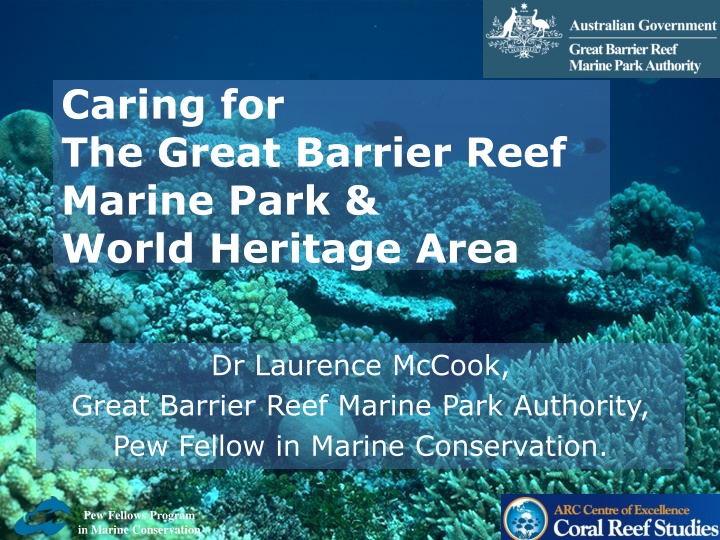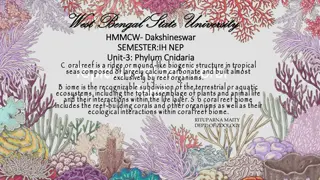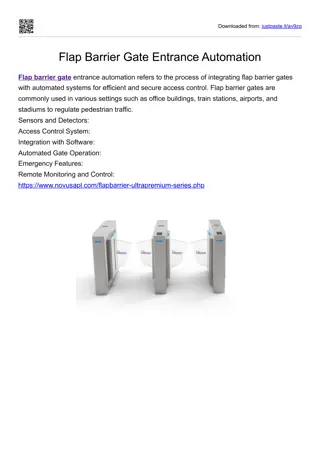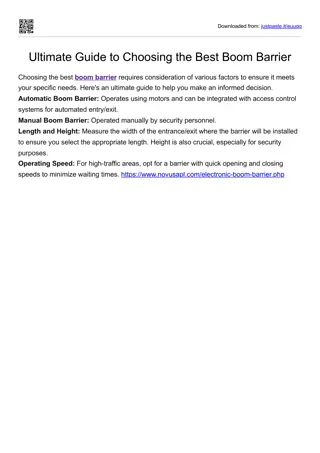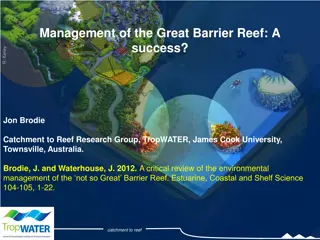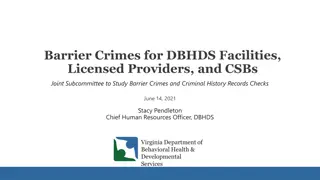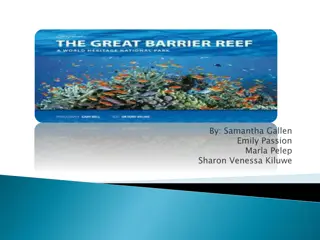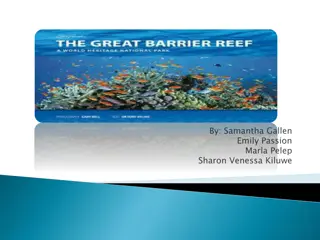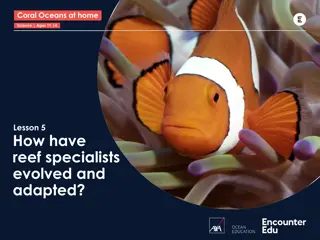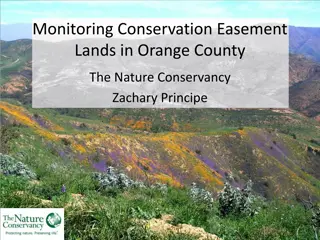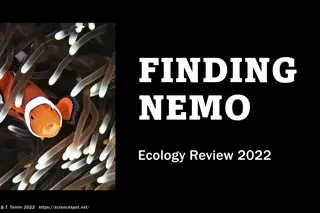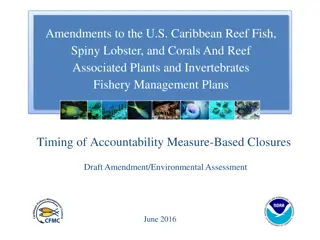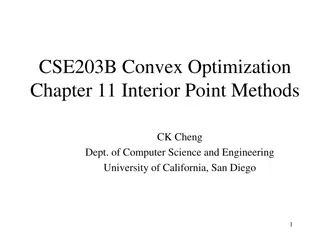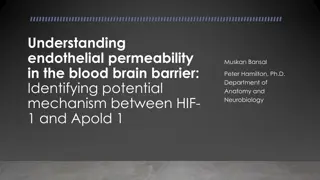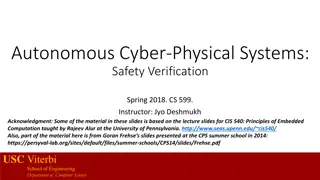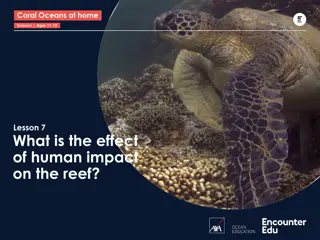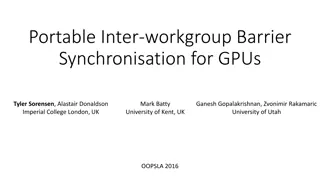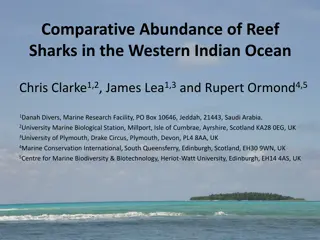Conservation Efforts and Management Strategies for the Great Barrier Reef
Dr. Laurence McCook, an authority on the Great Barrier Reef Marine Park, discusses the environmental, social, and economic importance of the reef. The key management tool of zoning, part of an integrated strategy, regulates activities in different zones to ensure conservation. Through adaptive management and assessing effectiveness, stakeholders aim to preserve the reef's ecosystem and biodiversity. Reviewing outcomes shows improvements in fish populations and ecosystem-wide benefits. The failure of collapse in the recreational fishery highlights the success of conservation efforts.
Download Presentation

Please find below an Image/Link to download the presentation.
The content on the website is provided AS IS for your information and personal use only. It may not be sold, licensed, or shared on other websites without obtaining consent from the author.If you encounter any issues during the download, it is possible that the publisher has removed the file from their server.
You are allowed to download the files provided on this website for personal or commercial use, subject to the condition that they are used lawfully. All files are the property of their respective owners.
The content on the website is provided AS IS for your information and personal use only. It may not be sold, licensed, or shared on other websites without obtaining consent from the author.
E N D
Presentation Transcript
Caring for The Great Barrier Reef Marine Park & World Heritage Area Dr Laurence McCook, Great Barrier Reef Marine Park Authority, Pew Fellow in Marine Conservation. Pew Fellows Program in Marine Conservation
Introduction GBR place of extraordinary environmental, social & economic value. Beauty. Pew Fellows Program in Marine Conservation
Adaptive Management & assessing effectiveness Conceptualize Adapt & Revise Actions & Monitoring Plan actions & Monitoring Analyze & Review effectiveness Implement Actions & Monitoring Review of zoning Outlook Report Strategic Assessment
Great Barrier Reef Zoning (a global standard for marine conservation) Key management tool (But only 1 part of integrated portfolio of strategies) In different zones, activities are: allowed as of right require a permit Prohibited Best practice design & implementation; Rigorous & accountable principles of conservation science Large area
5 years on: review & synthesis of outcomes 21 leading scientists from Great Barrier Reef; Fish Sharks Corals & Starfish Non-reef habitats Seabed habitats Dugong Turtles Compliance Social surveys Economics
Outcomes: More, biggerfish in protected areas Clear, widespread evidence for long-term benefits; Requires good compliance & enforcement; Possible widespread depletion, by 1984 (inshore)
Ecosystem-wide benefits for fish: the network Benefits to other reserves; Most larvae on reserve & fished reefs from protected reserve reefs; Good for fisheries & entire ecosystem
Social information: Failure of collapse in recreational fishery Recreational vessel registrations: 85000 2004 Zoning Plan 80000 75000 70000 65000 60000 55000 50000 Jun-02 Jun-03 Jun-04 Jun-05 Jun-06 Jun-07 Jun-08 Jun-09 Dec-01 Dec-02 Dec-03 Dec-04 Dec-05 Dec-06 Dec-07 Dec-08
Economics of reef management (assumptions vs evidence) Recreational Use 6 2004 Zoning Plan 5 Commercial Fishing $ Billions 4 3 Tourism 2 1 0 Cost Cost Revenue Cost Revenue Revenue 2006-07 2005-06 2004-05 Income: Reef contributes $5.5 billion/yr & ~53,800 full time jobs; increasing Costs: Great Barrier Reef Marine Park Authority: < 0.7 % of revenue Enforcement <0.3% Structural Adjustment - $211 million: <4% of 1 yr revenue
Outlook: Risks & challenges A stock take of where we have come from, where we are at & where we are going A synthesis of science & other relevant information to the Great Barrier Reef Assesses management effectiveness www.gbrmpa.gov.au/outlook-for-the-reef/great-barrier-reef-outlook-report
Existing protection & management All management, not just by GBRMPA Independent assessment (by 2 internationally recognised experts) High level review of 12 key management topics Input from Queensland & Australian Government agencies Adapted from Hockings et al. 2006, IUCN WCPA
Overall Outlook 2009 "The outlook for the Great Barrier Reef ecosystem is at a crossroad, and it is decisions made in the next few years that are likely to determine its long-term future"
Emerging issues Outlook 2009 Outlook 2014 Declines: corals; seagrasses; dugongs; turtles; Accumulation of impacts: Need for coordinated, integrated management across issues, time, space... (carrying capacity / upper limits) Unprecedented growth in coastal development ports, shipping, urban & mining/industrial Pressures on inshore biodiversity World Heritage Committee Concerns re: approval of port facilities within GBR World Heritage Area Heritage Step up in management of impacts for long-term, large scale...
GBR Strategic Assessment Provide overarching assessment of effectiveness of management arrangements to protect Great Barrier Reef values GBRMPA (marine) & State (Queensland) components to examine cumulative impacts on values multiple pressures from multiple activities rather than project by project assessments Ensure that management tools used are most effectively tackling the range of pressures on values Strongly linked to 5 year Outlook Report cycle.
Summary: Adaptive management of the Great Barrier Reef 5 yearly Outlook Report; Strategic Assessment of management effectiveness; Reef has declined; Need a step-up in management to maintain values. Reserve network: Significant ecosystem benefits; Probable benefits to tourism & fisheries Highly Cost-effective 1 part of package of complementary management www.gbrmpa.gov.au
